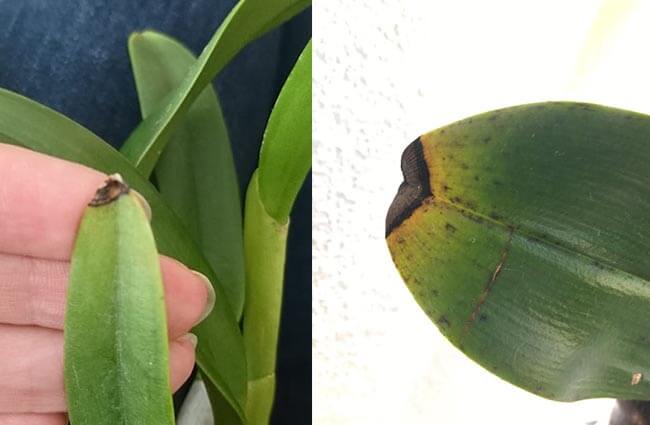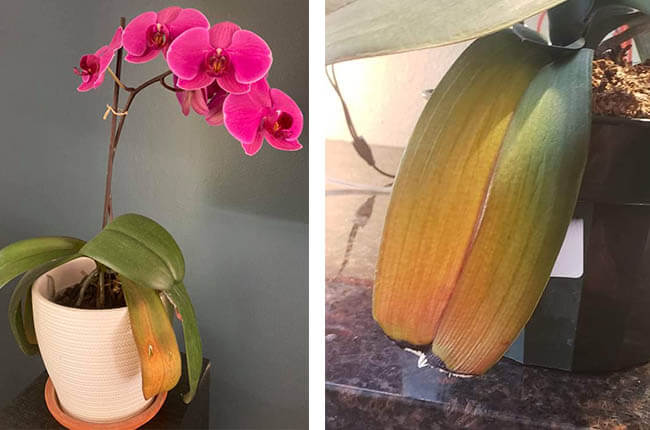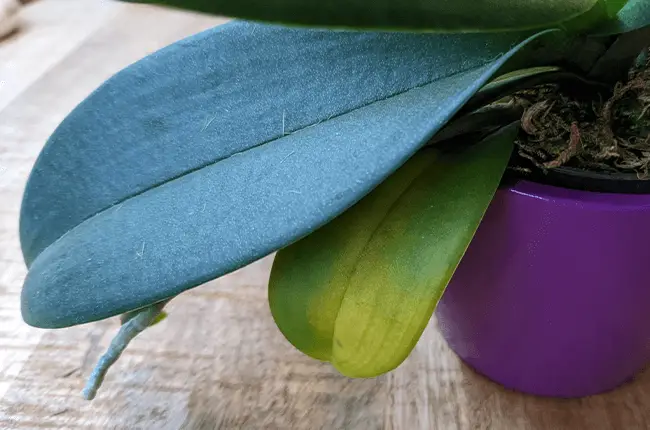When leaves turn yellow or brown, they are often misdiagnosed as sunburn, overwatering, or fungal/bacterial infection. When bottom leaves drop, the problem is often ignored as natural shedding.
While disease can be a cause, nutritional deficiency is most likely the root cause that makes a plant more vulnerable to fungal/bacterial diseases and rotting. Simply removing the yellow leaf would not solve the deep-rooted problem.
Nutritional deficiency often manifests in spring and summer during the active growth phase, when orchids need to be fed large quantities of nutrients for putting out leaves and later on blooming.
So, what does nutritional deficiency in orchids look like?
Nutritional deficiency causes a yellowing of leaves (chlorosis), scorched black leaf tips and margins and an eventual leaf drop and bud blast (necrosis). These symptoms can manifest in new growths (often due to Calcium deficiency) and in old growths (low in Magnesium, Nitrogen and Potassium).
This article will take a deep look at four common nutrient deficiencies in orchids, complete with pictures to help you diagnose the health of your orchid.
Quick Summary

Problem | Solution |
Calcium Deficiency (Black rot on new leaf tips & margins) | Cal-Mag |
Magnesium Deficiency (Yellow mosaic on older leaves, black rot) | Cal-Mag (same as above), or Epsom salt |
Nitrogen Deficiency (Yellow mosaic on older leaves, no black rot) | rePotme Orchid food |
Potassium Deficiency (Black rot on older leaves, leaf drop) | Better-Gro |
For recommendations on the best orchid fertilizer, we have done a comprehensive review of the 10 most popular fertilizers in the market.
Common Nutrient Deficiency in Orchids
It is often believed that plants need large quantities of Nitrogen (N), Phosphorous (P), and Potassium (K).
However, a study on various orchid species has found that orchids need large quantities of Calcium (Ca), Magnesium (Mg), followed by Phosphorous (P) and Potassium (K).
A nutrient mineral analysis performed by Naik and Barman (2007) looks at the nutrient composition of leaves from various epiphytic orchids by measuring the dry weight of 6 macronutrients.
It found that the main contents of the leaves are Ca and Mg which are in much higher quantities than N, P, and K, unlike what is often believed.
The results from the nutrient analysis are as follows:
| Nutrient | Weight of dry matter ( g/kg ) |
| Nitrogen | 2 – 8.7 |
| Phosphorous | 0.3 – 2.3 |
| Potassium | 3.2 – 14.3 |
| Calcium | 14.3 – 38.3 |
| Magnesium | 2.4 – 28.4 |
| Sulphur | 0.16 – 0.86 |
Because of the high levels found in the orchid leaves, these four nutrients are in higher demand. Thus, orchids are most likely to be deficient in Calcium and Magnesium, followed by Potassium and then Nitrogen.
As for the micronutrients, a deficiency would rarely occur to such an extent that it would cause significant health issues, such as yellow leaves or leaf drop because they contribute to such a small part of the leaves.
This is why this article focuses on the deficiency of these 4 nutrients.
Mobile and Immobile Nutrients
To understand nutrient deficiency in plants, we need to understand that some nutrients are mobile (e.g. Nitrogen, Phosphorous, Potassium) inside a plant that they are pulled from the reserves stored in another part of the plant if they are lacking in the external source.
Other nutrients are immobile (e.g. Calcium, many micronutrients). Once they are absorbed, they cannot be mobilized inside the plant from one place to another when needed.
| Mobile nutrients | Immobile nutrients |
| Nitrogen | Calcium |
| Phosphorous | Sulphur |
| Potassium | Boron* |
| Magnesium | Iron* |
| Mulybdenum | Manganese* |
| Chlorine | Copper* |
| Zinc* | |
| Old growths would show deficiency if lacking in these | New growths would show deficiency if lacking in these |
Deficiency in mobile nutrients affects older growths (e.g. leaves, stem, bulbs, canes) because the new growth would pull these nutrients from the reserves in the old growths.
On the other hand, deficiency in immobile nutrients affects new growths because they cannot be transported freely inside the plant.
In general, deficiency symptoms manifest as chlorosis, i.e. yellowing of leaves due to a loss or disruption in the production of chlorophyll. It can appear on the edges of a new or old leaf or between the veins as a mosaic pattern and with visible green veins.
It can also manifest as necrosis, i.e. cellular death, causing tissues to turn dry, brown or black. They often affect the leaf margins but can spread. It can cause an eventual leaf drop or bud blast.
| Ca | Mg | N | K | |
| Yellow mosaic pattern (chlorosis) between veins or margins | Old growths | Old growths | ||
| Dry, black rot (necrosis) in tips and margins | New growths | Old growths | ||
| Dry, black rot (necrosis) between veins or margins | Old growths | |||
| Leaf drop, bud blast in severe cases | New growths | Old growths | Old growths |
Deficiency Symptoms in New Growths
When problems are noticeable with new growths, it is often a Calcium deficiency problem.
This is because, amongst the immobile nutrients that can cause problems with new growths, Calcium and Sulphur are the only macronutrients that are needed in large quantities.
Also, according to the aforementioned nutrient analysis of orchid leaves (see Table 1 above), the leaves of orchids have a much higher Calcium content (between 14.3 and 38.3 g/kg) than Sulphur (between 0.16 and 0.86 g/kg).
Calcium is thus often deficient in house plants and needs to be replenished by applying fertilizer.
1. Black rot on new leaf tips & margins (Ca deficiency)
Symptoms:
The damage on the new shoots is commonly known as “die-back”. The tissue at the very tip or margin of a new leaf becomes dry and black due to necrosis. There is a very sharp demarcation between the dead and the living tissues. And it can progress slowly down the leaf.
Sometimes, the dead part of the leaf can suffer from a secondary infection by a fungus that feasts on the dead tissues, creating a yellow band or wash affecting the living tissue next to the dead tissue.
The same problem can manifest in buds. Severe deficiency can cause leaf drop and bud blast.

Cause:
Black rot on leaf tips is due to an accumulation of salts or nutrient minerals on the leaf tips. The accumulation of salts is not only caused by over-fertilization but most commonly a deficiency of Calcium, which is crucial in making new cells and cell walls.
When spring comes with warmer temperatures and longer daylight, orchids enter a growth phase when they need a lot of calcium to build new cell walls to put out new growths, including roots, leaves, pseudobulbs, flower spike, flower buds, etc.
But, Calcium, being an immobile nutrient, cannot be pulled from the reserves stored in other parts of the plant. It needs to be given from an external source in the form of fertilizer for houseplants. With a deficiency in Calcium, growth is stunted.
Meantime, nutrients are being pumped to the meristem or the active growing tips. Research shows that there are 5 times more nutrients at the growing tips than the other parts of the plant. If there are not enough new growths due to a deficiency in Calcium, too many nutrients would be accumulated at the delicate growing tips, causing fertilizer burn or dieback. Black rot thus sets in.
Solution:
The dead part of the leaf should be cut off using sterilized pruners as the dead tissues can lead to secondary infection by fungi spreading to other parts of the plant.
Meantime, the calcium deficiency needs to be corrected by feeding the orchid Cal Mag solution (60 ppm or 1/4th a teaspoon of Ca/Mag per gallon of water) at least once a week for 3 weeks. Improvement can be observed after a few weeks.
If you have been feeding your orchids with fertilizer and still notice deficiency symptoms, the Calcium and Magnesium content may be quite low and would thus need additional feeding especially during the growing phase.
Also, the optimal pH for the uptake of calcium is 5 and 5.8. So, pay attention to the pH of the medium. If your moss and bark medium is broken down, it may be too acidic for the absorption of Calcium.
Deficiency Symptoms in Old Growths
1. Yellow mosaic pattern on older leaves & black rot (Mg deficiency)
Symptoms:
Orchids with Magnesium deficiency develop a mosaic (or speckled) pattern, called chlorosis, on the older leaves. It can be patches of green and yellow or visible green veins in a discolored leaf. For orchids with purple or red flowers, chlorosis will display purplish pigmentation.
Magnesium deficiency can also lead to cellular death (necrosis) or black rot between the veins or on the leaf edges.
Severe deficiency can lead to leaf drop and bud blast.

Cause:
Magnesium is an important mineral for chlorophyll production, amongst other functions such as maintaining strong cells. When it runs out, chlorophyll production will be disrupted, resulting in a mottled appearance.
Since Magnesium is a mobile nutrient, it is pulled from the older structures, such as a bottom leaf in the production of new growths.
Solutions:
Use a Cal-Mag solution, Magnesium Sulphate, or Epsom salt in a concentration of 160 ppm in rainwater, or 1 tsp per gallon (4 liters), once every week for 3 times. The improvement will be observed after the third feeding.
If the brown patches continue to spread, action must be taken immediately using bactericide or removing the rotten part using sterilized cutters.
2. Yellow mosaic in older leaves with no black rot (N deficiency)
Symptoms:
Nitrogen deficiency often manifests in one or two older leaves with yellowing between veins or the edges, looking like a mosaic (chlorosis). This happens during the active development of foliage and green structures such as leaves, canes, and pseudobulbs.
The damage caused by nitrogen deficiency affects the leaf tips and extremities, causing them to curl and eventually can stunt growth.
Unlike Magnesium deficiency, Nitrogen deficiency does not cause cellular death, black rot, or leaf drop.

Cause:
During foliage development, when nitrogen is lacking from the environment, the mobile nutrients are pulled from the reserves stored in the older leaves, making them turn yellow.
Solution:
Use a nitrate-based fertilizer (e.g. rePotme MSU ) weekly, weakly. If you have been applying that and the results are not noticed. Check the pH of the medium to see if it’s within the optimal range of 5.5 – 6.5.
After a few feedings, the yellow leaves can become greener, although they would never return to what they used to be. If the damage is severe, it would not be reversible.
3. Black rot on older leaves & leaf drop (K deficiency)
Symptom:
Potassium deficiency causes cellular death (necrosis) on leaf tips and margins, which will become dry and brown or black. Severe potassium depletion can cause leaf drop and bud blast.
Unlike Magnesium and Nitrogen deficiency, Potassium deficiency does not cause leaves to turn yellow (chlorosis).
Potassium deficiency often manifests during the blooming phase when large quantities of potassium is needed.

Cause:
Potassium is a mobile nutrient, so deficiency appears on the older leaves.
When there is a need for potassium during the blooming phase but cannot absorb that from the environment, the new growth would pull the mobile mineral from the reserves stored in the older structures (e.g. a bottom leaf, an older pseudobulb).
Solution:
Use a fertilizer with high potassium (e.g. Better-Gro Better Bloom 11-35-15) weekly, weakly. If you have been applying that and results are not noticed, check the pH of the medium to see if it’s within the optimal range of 5.5 – 6.5.
Is it Nutritional Deficiency or Bacterial infection?
You may wonder about the difference between nutritional deficiency and bacterial infection because both have very similar symptoms: yellowing of leaves in a mosaic pattern (chlorosis), brown or black spots, black tips and edges, and an eventual leaf drop.
The difference is that the damage caused by nutritional deficiency is regular and symmetrical, e.g. mottled pattern, halo, brown spots evenly distributed. But, the damage by bacterial infection looks random.
Is it Nutritional Deficiency or Sunburn?
Many people often misdiagnose the yellowing of leaves as sunburn. There are three ways to tell whether orchids are suffering from sunburn or nutritional deficiency.
First, sunburn causes a discoloring (or whitening) of orchid leaves and it happens in large patches, not just a few spots and not an entire leaf. In contrast, orchids suffering from chlorosis due to nutritional deficiency become yellow and often have a mottled pattern.
Second, sunburn affects the top leaves that are closer to the sun, rather than the bottom ones that are shielded from the other leaves. If one leaf suffers from sunburn, a neighboring leaf is often affected as well.
Finally, the easiest way is to check if the orchid has been growing in a position with direct, unfiltered sunlight.
To learn more, here is an article about sunburnt orchids.
Is it Nutritional Deficiency or Overwatering?
Overwatering often leads to root rot and stem/crown rot which are major immediate causes for orchids losing leaves.
However, if an orchid has a lot of healthy roots, is growing new roots and if the medium is not broken down, the problem of overwatering should be ruled out.
Conclusion
To sum up, mineral nutritional deficiency in orchids (also in plants) can cause the yellowing of leaves often in a mosaic or halo pattern and sometimes with visible veins (chlorosis); it can also result in cellular death with dry, black leaf tips and margins (necrosis).
These symptoms can manifest in new growths as dieback (often due to Calcium deficiency), or in old growths (due to deficiency in Magnesium, Nitrogen, and Potassium).
Nutrient deficiency should not be confused with sunburn, overwatering, and fungal/bacterial infections as the cause of leaf yellowing.
If an orchid is well-nourished, the older leaves would not always shed; it would have thick cell walls that are more resistant to fungal and bacterial infection and pest attacks, and crown rot would not happen easily with water on their leaves.
Next time you see a leaf turning yellow or brown, before running off to spray it with fungicide or pesticide, it could be just a nutritional problem and can be corrected by feeding your orchid properly (Here is a comprehensive guide on how to fertilize orchids).
Happy gardening!
Sources
Marschner, H. (2011). Mineral Nutrition of Higher Plants. Academic Press.
Naik, S. K. & Barman, D. (2007). Distribution of nitrogen, phosphorus, potassium, calcium, magnesium and sulphur in different orchid species of Sikkim. Journal of Ornamental Horticulture, 10 (4): 255-259, October-December 2007
Related
Fertilizing Orchids, TDS and PPM (All You Should Know)
Orchid Nutrition and Fertilizer: A Complete Guide
Top 10 Orchid Fertilizers: A Detailed Review
Why You Should Foliar Feed Orchids (& How To Do It Right)
- Top 6 Drip Irrigation Systems for Raised Beds (2025) - January 31, 2025
- Top 10 Orchid Fertilizers: A Comprehensive Review (2025) - January 16, 2025
- Top 6 Slow-Release Fertilizers for Houseplants & Veggies (2025) - January 15, 2025





